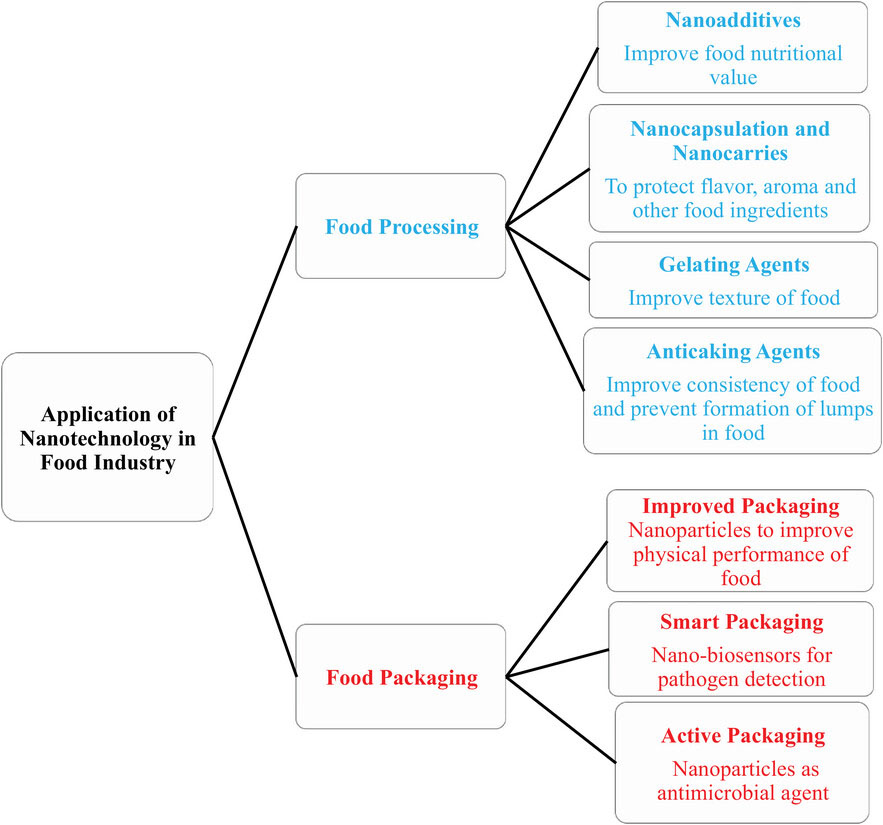| Feb 12, 2024 | |
How can nanotechnology transform food safety worldwide? |
|
| (Nanowerk Spotlight) Researchers worldwide have been harnessing the special characteristics of nanomaterials for improving industries like medicine, energy, and agriculture. There is accelerating interest in applying nanotechnology to enhance food quality, safety, packaging, and preservation as well. | |
| These issues are highly relevant and urgent as food safety remains an enduring concern worldwide, especially in less developed regions, with contaminated foods leading to widespread illnesses and even death. Persistent challenges like microbial and chemical contamination, poor food handling practices, fraud, and environmental pollution continue to plague food supplies globally despite conventional interventions. | |
| A recent paper published in Nano Select ("Boosting food safety in Ghana: Exploring the future of nanotechnology") reviews the potential of nanotechnology specifically for boosting food safety by using the case of Ghana. Ghana faces many of the above-mentioned food safety issues, with contaminated water, soil, produce and meats sickening consumers. | |
 |
|
| Nanotechnology applications in the food industry. (Reprinted with permission by Wiley-VCH Verlag) | |
| The review article spotlights nano-based methods already demonstrating efficacy against current food safety issues in the country and similar developing nations. The authors highlight five priority applications showing particular promise if adopted in Ghana: | |
Nanosensors for Detecting Contaminants |
|
| Special nano-scale biosensors made from tailored nanotubes or nano-scale enzyme/antibody receptors can rapidly detect food pathogens, toxins, pesticides, and other contaminants with higher sensitivity than conventional techniques. Easy-to-use portable kits utilizing such nanosensors could enable on-site safety analysis during food production, distribution, and preparation to better prevent and contain outbreaks. | |
Nano-Antimicrobials to Combat Resistance |
|
| Antimicrobial resistance is surging globally, rendering once-reliable drugs ineffective. But emerging nano-antimicrobials made with engineered nanoparticles of silver, titanium oxide, zinc oxide or chitosan can penetrate cells and circumvent common microbial defense mechanisms. Harnessing these nano-scale drugs appropriately could help overcome resistant pathogens in the food supply. | |
Active & Smart Nano-Packaging |
|
| Incorporating nanomaterials like silver nanoparticles, nano-clays, or chitosan nanoparticles into food packaging can transform passive wrappings into “smart” barriers better able to contain, preserve, and monitor food quality. These nanoparticles confer antimicrobial and moisture barrier properties. Nanotechnology-enhanced packaging shows promise for increasing shelf-life, reducing spoilage, and alerting consumers of contamination. | |
Nano-Remediation of Soil & Water |
|
| Widespread heavy metal and microbiological contamination plagues agricultural soil and water in Ghana, jeopardizing produce safety. But the high surface area and reactivity of tailored nanoparticles allows efficient absorption, breakdown, or conversion of environmental pollutants. Field trials applying various nano-remediation techniques report rapid, low-cost cleanup of pesticides and heavy metals. | |
Fraud Detection Using Nanoparticles |
|
| Deliberate food adulteration for profit, though dangerous, is commonplace in Ghana. Sophisticated frauds often evade conventional quality checks. But researchers have devised several nimble gold and silver nanoparticle-based tests that sensitively and selectively detect fraudulent additions with minimal equipment, know-how, and cost. | |
Realizing Nanotechnology’s Full Potential |
|
| However, several obstacles stand in the way of fully capitalizing on nanotechnologies for enhanced food safety. Regulations around rapidly developing applications often lag behind innovation. And toxicity data remains limited, especially regarding long-term effects. Standardized safety testing protocols are still lacking. This makes conclusive risk assessment difficult, hampering regulatory action and public confidence. | |
| Additionally, the nano-enabled solutions face adoption constraints around accessibility, affordability, public perception, and environmental impacts. Production costs could limit access, especially for small food producers in lower income regions. Transparent communication and ethical stewardship focused on societal benefits rather than mere profit will be essential for public acceptance. And life cycle analyses ensuring minimal ecosystem harm are needed for sustainability. | |
| Furthermore, outstanding questions persist regarding the migration potential and biological impacts of ingested nanoparticles, highlighting the need for further research even as applications advance. | |
Charting a Responsible Course Forward |
|
| With coordinated leadership and collaboration, proactive policies, rigorous science, and responsible development models focused on societal benefit, the barriers impeding nanotechnology’s food safety potential could be overcome. The authors offer recommendations for spurring progress: | |
|
|
| Through purposeful research, thoughtful regulation, ethical commercialization, and ongoing engagement, Ghana and similar nations could hasten the advent of nanotechnology-powered enhancements making their food systems safer and more resilient against entrenched risks. | |
| For a more comprehensive look at nanotechnology in the agricultural and food sector, read our primer here Nanotechnology in Food. | |
 By
Michael
Berger
– Michael is author of three books by the Royal Society of Chemistry:
Nano-Society: Pushing the Boundaries of Technology,
Nanotechnology: The Future is Tiny, and
Nanoengineering: The Skills and Tools Making Technology Invisible
Copyright ©
Nanowerk LLC
By
Michael
Berger
– Michael is author of three books by the Royal Society of Chemistry:
Nano-Society: Pushing the Boundaries of Technology,
Nanotechnology: The Future is Tiny, and
Nanoengineering: The Skills and Tools Making Technology Invisible
Copyright ©
Nanowerk LLC
|
|
|
Become a Spotlight guest author! Join our large and growing group of guest contributors. Have you just published a scientific paper or have other exciting developments to share with the nanotechnology community? Here is how to publish on nanowerk.com. |
|
